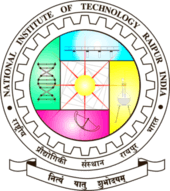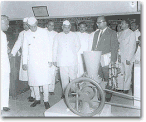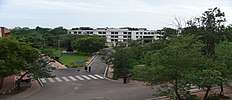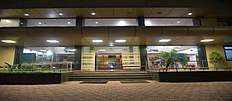National Institute of Technology, Raipur
National Institute of Technology, Raipur (abbreviated NIT Raipur or NITRR) is a publicly funded engineering and research institution located in Raipur, Chhattisgarh, India. Founded in 1956 with two engineering disciplines, Mining and metallurgy, it is one of the oldest institute in National Institutes of Technology system. It is recognized as an Institute of National Importance by the Government of India under the National Institutes of Technology Act, 2007.[3] and is currently undergoing accelerated growth through the World Bank-funded Technical Education Quality Improvement Program (TEQIP).[4]
 Seal of the National Institute of Technology Raipur | |
| Motto | Sanskrit: नित्यं यातो शुभोदयं |
|---|---|
Motto in English | Let the rise of goodness happen every day |
| Type | Public engineering school (INI) |
| Established | 1956 |
| Director | Dr. A M Rawani |
Academic staff | 333 [1] |
| Undergraduates | 4304 [1] |
| Postgraduates | 1100 [1] |
| Location | , , 21°14′57.84″N 81°36′17.64″E |
| Campus | Urban |
| Language | English |
| Colours | Blue Yellow Pink Green |
| Nickname | NITians, Raipur-NITians |
| Affiliations | UGC India MHRD AICTE[2] |
| Website | www |
History

The first President of India, Rajendra Prasad laid the foundation stone of the college building on 14 September 1956. Construction was completed in 1962 and the college was inaugurated on 14 March 1963 by the first Prime Minister of India, Jawaharlal Nehru. Until as late as 1956, there were only three technical institutes in the country devoted to mining and metallurgical engineering. In view of this fact and also with the aim of harnessing the ample mineral resources in the region, the institute was set up on 1 May 1956 as Government College of Mining and Metallurgy. The first session of the college commenced on 1 July 1956 with the admission of 15 students each in mining and metallurgical engineering.[5]
In 1958–59 with the commencement of additional courses in civil, mechanical and electrical engineering, the college came to be known as Government College of Engineering and Technology. Later graduate courses in chemical engineering (1965), architecture (1984), electronics (1985), information technology, computer science and technology (2000), biotechnology and biomedical engineering (2003) were started. It was declared a National Institute of Technology (NIT) by the Government of India on 1 December 2005 and then declared an Institute of National Importance with the passing of the National Institutes of Technology Act, 2007, in May 2007.[6]
Administration

The President of India is the ex officio visitor of all the National Institutes of Technology (NITs). The National Institutes of Technology Council (NIT Council) works directly under him and it includes the minister-in-charge of technical education in Central Government, the Chairmen and the Directors of all the NITs, the Chairman of University Grants Commission (India), the Director General of Council of Scientific and Industrial Research, the Directors of other selected central institutions of repute, members of Parliament, Joint Council Secretary of Ministry of Human Resource Development, nominees of the Central Government, All India Council for Technical Education and the Visitor. Below the NIT Council is each NIT's Board of Governors. The Board of Governors of each NIT consists of the chairman and ten members, which include government, industry, alumni and faculty representation.
The Director serves under the Board of Governors, and is the school's chief academic and executive officer. Academic policies are decided by its Senate, which is composed of some professors and other representatives. The Senate controls and approves the curriculum, courses, examinations, and results. Senate committees examine specific academic matters. The teaching, training, and research activities of various departments of the institute are periodically reviewed to maintain educational standards. The Director is the ex officio Chairman of the Senate. The Deputy Director is subordinate to the Director. Together they manage the Deans, Heads of Departments, Registrar, President of the Students' Council, and Chairman of the Hall Management Committee. Deans and Heads of Departments in NITs are administrative postings rather than career paths. Faculty members serve as Deans and Heads of Departments for limited periods, typically 2 to 3 years, then returning to regular faculty duties. The Registrar is the chief administrative officer and overviews day-to-day operations. Below the Head of Department, are the various faculty members (professors, assistant professors, and lecturers).
The Warden serves under the Chairman of the Hall Management Committee.
Academics
Admissions
- Admission to the undergraduate programmes is very competitive and is based on the rank secured in the Joint Entrance Examination (Main). Candidates must also secure at least 75% marks in the 12th class examination, or be in the top 20 percentile in the 12th class examination conducted by the respective Boards. For Scheduled Castes/Scheduled Tribes students, the qualifying marks would be 65% in the 12th class examination. The Joint entrance exam (Main) is considered to be one of the toughest examinations in the world.
- NIT Raipur follows the reservation policy declared by the Supreme Court of India, by which 27% of seats are reserved for Other Backward Classes, 15% for Scheduled Castes, 7.5% for Scheduled Tribes and 10% for EWS category students. The institute also accepts foreign nationals through scholarships awarded by the Government of India, and non-resident Indians through an independent scheme known as Direct Admission for Students Abroad that uses SAT scores.[7]
- Admissions to the postgraduate programmes are through the Graduate Aptitude Test in Engineering for the Master of Technology (M.Tech.) and Master of Science programs (taught and research), and through NIMCET for the Master of Computer Applications (M.C.A) program.
Undergraduate education
The institute awards Bachelor of Technology (B.Tech.) degrees in eleven engineering disciplines as well as the Bachelor of Architecture (B.Arch) degree through its architecture program.
The B.Tech. and B.Arch degree programmes are four and five years long respectively. Courses are allotted number of credits according to their importance. Each academic year is divided into two semesters and teaching programmes are organized around the credit system. Teaching includes lectures, tutorials, practicals, projects, seminars, dissertations, and field and industrial training. The first year of the B.Tech. programme is common across all disciplines, during which students take basic courses in engineering, mathematics and professional communication. From the second year onward, the students take courses offered by their departments that are known as depth courses. At the end of the third year, the B.Tech students undertake industrial training for a minimum period of eight working weeks as part of the undergraduate curriculum. In the final year of their studies, most of the students are offered jobs in industries and other organizations through the Training and Placement section of the institute. Some students opt out of this facility in favour of higher studies or by applying to recruiting organizations directly.[8]
Postgraduate education
The institute also offers graduate programmes in science and engineering, leading to a Master of Science (M.Sc.) or Master of Technology (M.Tech.) degree respectively, as well as a program in computer applications (MCA).
The Department of Computer Applications offers full-time post-graduate programme — three-year Master of Computer Applications (MCA) programme.
Most of the institute's academic departments offer Doctorate of Philosophy (PhD) degrees programmes under its own HOD. Admission to the PhD degree programs is through an entrance exam conducted by the institute. The doctoral research scholars are given a topic by the professor, or work on the consultancy projects sponsored by industry. The duration of the programme is usually unspecified and depends on the discipline. PhD scholars submit a dissertation as well as conduct an oral defence of their thesis. Teaching assistantships (TA) and research assistantships (RA) are provided based on the scholar's profile. After the completion of doctoral studies, the candidates are placed in reputed public or private companies and universities. Also many of the students after finishing their doctoral studies, do post doctoral fellowships at research labs and universities in India and abroad.[9]
Departments
At present the institute offers graduate level courses in twelve disciplines.[10]
The institute currently houses the following departments:[10]
| Engineering | Other Departments |
|---|---|
| Science | Architecture |
|
Student Life
Raipur Campus

The Institute has a well-organized, magnificent building symbolizing the grandeur of the institute. This huge building alone covers a total area of 62060 sq.m. It is a triple storied planned structure along with a central tower standing up to the height 23 meters. There are 35 lecture halls extending over an area of 6675 sq.m & 13 drawing halls/studios extending over an area of 3510 sq.m. about 85 labs over an area of 11510 sq.m. The other amenities consist of a small canteen, cycle stand, N.C.C, N.S.S department, a student activity center co-operative store, dispensary and a Makerspace. The building is being further extended for the architecture and electronics departments.[11] Student Housing

There are separate hostel facilities for boys and girls: six for boys and two for girls. Each hostel has its own mess. Dinner is not provided on Sundays only in the boys hostel. There are two hostel for girls, each having a capacity of 150 and 250. Admission to the hostel depends upon the Joint Entrance Examination – Main rank and the distance of their native place from the institute.
| HOSTEL-1 (MAINPAT) | HOSTEL-6 (KOTUMSAR) |
| HOSTEL-2 (CHITRAKOT) | Girls HOSTEL-7 |
| HOSTEL-3 (TIRATHGARH) | HOSTEL-8 (SIRPUR BLOCK-I) |
| HOSTEL-4 (MALHAR) | HOSTEL-8 (SIRPUR BLOCK-II) |
| Girls HOSTEL-5 | Girls HOSTEL- PG |
Central Library
The Central Library of NIT, Raipur has a good collection of more than 1 crore of documents consisting of text books, reference books and back volume journals. Besides it has subscription to a good numbers of print journals and online resources. The library automation program through LibSys7- Library management software is in progress .It caters to the information and document need of nearly 5000 users consisting of Faculty members, staff, B.Tech/M.Tech/MCA students and research scholars satisfactorily.[11]
Sports
All the activities are managed by students under the guidance of SAS Officer and Faculty In-Charge Sports. The prime bodies under sports department is activity center and GYM, which provide avenues for
various sports events, indoor and outdoor games. Students are also encouraged and facilitated to take part in similar events in other institutions. Sports Department National Institute of Technology Raipur has been known for its excellence, in Sports and the students keep raising the bar for themselves by proving to be a step ahead of the crowd, time and again. The institute, at the same time, also has records of achievements in curricular as well as extra-curricular activities. An extremely crucial role is played by Sports department of the institute in facilitating the activities and reaching out to the students. GYM is an Institute governed organization that cultivates leadership, encourages students to participate in outdoor activities, and provide facilities for games and sports. The members of the staff monitor activities of Gym and help students in organizing and managing their functions. Sports department provides facilities for outdoor games like Athletics, Cricket, Football, Hockey, Badminton, Basketball, Baseball, Lawn Tennis, Swimming, Gymnastics, Yoga Exercises, and Volleyball etc. Each game is looked after by a Captain and Sports Officer. All the games are properly run with the assistance of Sports Officer.
Guest House
Guest House of the institute provides accommodation facility to the institute guests, guests of the students of the institute, parents of the students, visitors from other NITs and educational institutes, participants of the activities organized by the institute and persons with approval from appropriate authorities. Guest house has three living rooms, one dining hall and one hall.
Sports
Festivities
The student clubs host a number of annual fests or events, inviting participants from colleges across the nation.[12]
Rankings
| College rankings | |
|---|---|
| Engineering – India | |
| NIRF (2019)[13] | 74 |
| NIRF (2020)[14] | 67 |
| The Week (2018)[15] | 48 |
National Institute of Technology, Raipur (NITRR) is ranked 67 among engineering colleges by the National Institutional Ranking Framework (NIRF) in 2020.[13]
Notable alumni
The institute has an active alumni network, with chapters across India, in the United States and in Europe.
National Institute of Technology, Raipur alumni include Chief Executive Officers and top executives of Fortune India 500 companies such as Abid Ali Neemuchwala, Chief Executive Officer (CEO) of Wipro, Sudhir Vasudeva, Former Chairman & Managing Director at ONGC,[16] Satish Sharma, President and Director of Apollo Tyres.[17] Bureaucrats like Deepak Khandekar, Chief Secretary, Ministry of Tribal Affairs.
In the academic world, they include deans and chairs of faculties such as Baldev Raj, an Indian scientist and director of the Indira Gandhi Centre for Atomic Research (IGCAR), Dharma Agrawal, Distinguished Professor of Electrical Engineering and Computing Systems at the University of Cincinnati.
Politicians like Gaurishankar Agrawal, Former Speaker of Chhattisgarh Legislative Assembly, Abhishek Singh, Member of Parliament from Rajnandgaon, Shivshankar Painkra, Zale Neikha, Member of Nagaland Legislative Assembly and artists like Padma Shri Budhaditya Mukherjee.
References
- http://www.nitrr.ac.in/nirf_data.php
- http://mhrd.gov.in/technical-education-5
- "Institutions | Government of India, Ministry of Human Resource Development". mhrd.gov.in. Retrieved 17 September 2018.
- R. Krishnamoorthy (3 November 2008). "TEQIP Phase II to create parity between NITs and IITs". The Hindu.
- "::: National Institute of Technology Raipur :::". www.nitrr.ac.in. Retrieved 1 August 2018.
- "Institutions of National Importance".
- "DASA".
- "BTech_Ordinance" (PDF).
- "Admissions".
- "::: National Institute of Technology Raipur :::". www.nitrr.ac.in. Retrieved 27 October 2017. Click on "Department".
- "::: National Institute of Technology Raipur :::". www.nitrr.ac.in. Retrieved 2 September 2018.
- "::: National Institute of Technology Raipur :::". www.nitrr.ac.in. Retrieved 2 September 2018.
- "National Institutional Ranking Framework 2019 (Engineering)". National Institutional Ranking Framework. Ministry of Human Resource Development. 2018.
- "National Institutional Ranking Framework 2020 (Engineering)". National Institutional Ranking Framework. Ministry of Human Resource Development. 11 June 2020.
- Vandana (17 June 2018). "Perfect blend: The Week-Hansa Research Best Colleges Survey: Top Engineering Colleges – All India". The Week.
- "Institutions | Government of India, Ministry of Human Resource Development". mhrd.gov.in. Retrieved 17 September 2018.
- "::: National Institute of Technology Raipur :::". www.nitrr.ac.in. Retrieved 1 August 2018.
See also
| Wikimedia Commons has media related to National Institute of Technology, Raipur. |